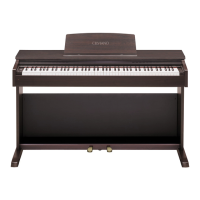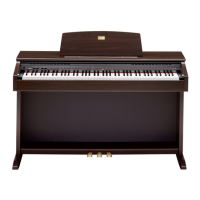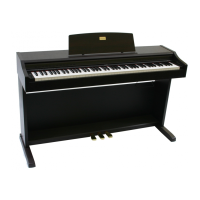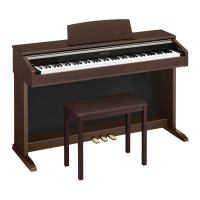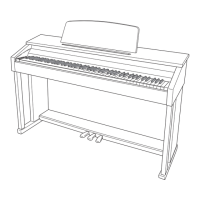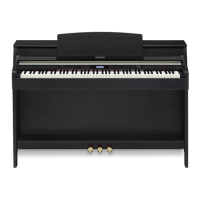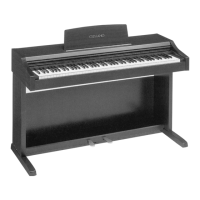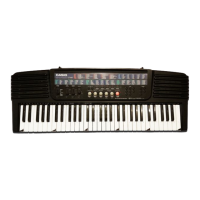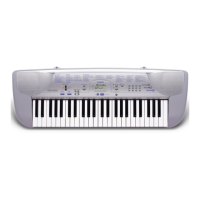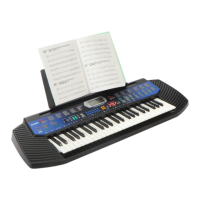Do you have a question about the Casio Celviano AP-21 and is the answer not in the manual?
| Keyboard | 88 keys, weighted hammer action |
|---|---|
| Metronome | Yes |
| Speakers | 12cm x 2 |
| Amplifier Output | 8W + 8W |
| Amplifier | 8W + 8W |
| Sound Source | AHL (Acoustic & Highly-compressed Large-waveform) |
| Digital Effects | Reverb, Chorus |
| Recorder | 2-track recorder |
| Lesson Function | Yes |
| Pedals | Damper, Soft, Sostenuto |
| Terminals | MIDI IN/OUT, Headphones |
| Touch Sensitivity | 3 levels |
| Effects | Reverb, Chorus |
| Transpose | Yes |
| Tuning | A4 = 415.5 to 465.9 Hz |
| Connectors | Headphones, MIDI IN/OUT |
| Power Supply | AC adapter |
Provides instructions for safe electrical grounding of the product to reduce shock risk.
Explains the meaning of various safety symbols used in the user's guide and on the product.
Provides guidance on avoiding specific locations to ensure optimal operation and prevent interference.
Details on how to clean and maintain the instrument's exterior and parts safely.
Information about the lithium battery, its lifespan, and replacement.
Describes the eight built-in instrument tones, including piano and pipe organ.
Introduces eight demo tunes that showcase the instrument's built-in tones.
Explains the built-in memory for storing and playing back performances.
Details functions like Transpose, Tuning, and Touch Select for customizing the sound.
Allows selection of temperament and Baroque pitch for realistic classical music play.
Describes connecting to other MIDI instruments for expanded musical possibilities.
Details the various terminals and jacks located on the back panel of the instrument.
Identifies the controls and indicators located on the front of the instrument.
Covers the pedal connector and instructions for raising the score stand.
Guides on selecting and adjusting the 8 built-in instrument tones.
Instructions on assigning two tones simultaneously and adjusting their volumes.
Details on applying and selecting digital effects like Reverb, Chorus, and Tremolo.
Explains how keyboard touch affects sound output and character.
How to switch the left pedal between soft and sostenuto functions.
Details the operation and effect of the Damper, Soft, and Sostenuto pedals.
Covers memory capacity, recorded data types, and storage.
Step-by-step guide on how to record keyboard play into memory.
How to play back recorded song data from the memory areas.
How to play all demo tunes consecutively by pressing the DEMO button.
How to select and play a single demo tune repeatedly.
Method to stop the demo tune playback.
Adjusts keyboard touch response (Light, Middle, Heavy) for different playing styles.
Allows changing the key of the piano in semitone steps.
Adjusts the overall pitch of the piano ±50 cents from A4=440Hz.
Selects from three different tuning curves for enhanced acoustic effect.
Describes the standard tuning curve with specific cent offsets for low and high notes.
Details the electric piano tuning curve with specific cent offsets.
Explains the flat tuning curve dividing octaves into 12 equal semitones.
Step-by-step instructions to change the active tuning curve.
Describes the most widely used tuning system with equal frequency ratios.
Explains the Mean-Tone System used for keyboard instruments from Renaissance to 18th Century.
Describes the Pythagorean system developed by Pythagoras.
Details the Just Intonation system with acoustically correct fifths and thirds.
Step-by-step guide to changing the temperament and root settings.
Instructions to enable or disable Baroque pitch for historical performance.
Defines MIDI (Musical Instrument Digital Interface) and its purpose in exchanging musical data.
Covers the 16 MIDI channels and their use for data transmission and reception.
Describes the multi-timbre capability for receiving data on multiple channels simultaneously.
How to set the default MIDI channel for data transmission and reception.
Provides solutions for common problems encountered during operation.
Instructions for connecting to audio devices like amplifiers or tape recorders.
Guide on connecting headphones for private practice without disturbing others.
Instructions for connecting to musical instrument amplifiers.
Detailed steps for assembling the instrument's stand.
Lists the default settings applied when the CELVIANO is powered on.
